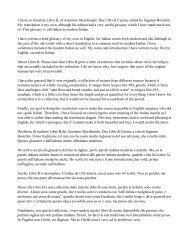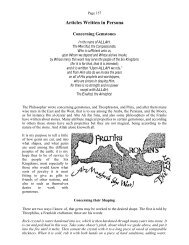How to Milk an Almond Stuff an Egg And Armor a Turnip A ...
How to Milk an Almond Stuff an Egg And Armor a Turnip A ...
How to Milk an Almond Stuff an Egg And Armor a Turnip A ...
Create successful ePaper yourself
Turn your PDF publications into a flip-book with our unique Google optimized e-Paper software.
of rice goes on<strong>to</strong> the burner. The rice is being cooked early because all the burners are needed for<br />
the last hour before the feast; a five gallon pot full of food should stay warm for a long time after<br />
it comes off the s<strong>to</strong>ve.<br />
Starting about 4:15, the eggpl<strong>an</strong>t that was earlier boiled is fried in sesame oil, using the large<br />
frying p<strong>an</strong> on burner 1. When that is done the frying p<strong>an</strong> is rinsed out <strong>an</strong>d used <strong>to</strong> fry the<br />
meatballs that are the other main ingredient in bur<strong>an</strong>.<br />
Obviously, lots of things are happening that are not shown on the chart. Meatballs <strong>an</strong>d pie<br />
crusts must be made, pie filling mixed, <strong>an</strong>d so forth. The chart was drawn on the assumption that<br />
none of those processes used scarce resources; there are plenty of plates <strong>to</strong> pile the meat balls on<br />
<strong>an</strong>d rolling pins for rolling out pie crusts. Equally obviously, unless this is a very small <strong>an</strong>d very<br />
oddly bal<strong>an</strong>ced feast, what is shown is only part of the chart; other resources are being used for<br />
other dishes.<br />
The purpose of drawing up such a chart is not <strong>to</strong> figure out exactly what everything will be<br />
used for at every inst<strong>an</strong>t. That is not possible; something is certain <strong>to</strong> go wrong, <strong>an</strong>d your pl<strong>an</strong>s<br />
will have <strong>to</strong> be revised on the spot. What the chart does is <strong>to</strong> show you whether or not it is<br />
possible <strong>to</strong> cook the feast you have pl<strong>an</strong>ned in the kitchen you are using <strong>an</strong>d where problems are<br />
likely <strong>to</strong> occur. If, after juggling alternative schedules, you discover that there is no way <strong>to</strong><br />
produce the feast without using two more burners th<strong>an</strong> you have, you c<strong>an</strong> ch<strong>an</strong>ge your pl<strong>an</strong>s<br />
accordingly. Perhaps you should have one more baked dish <strong>an</strong>d two fewer fried ones. Perhaps<br />
you should make <strong>an</strong> effort <strong>to</strong> get a couple of really large pots, thus allowing more food <strong>to</strong> cook on<br />
each burner. Perhaps you could shift the frying off the s<strong>to</strong>ve on<strong>to</strong> a couple of electric frying p<strong>an</strong>s.<br />
Whatever the solution, it is better <strong>to</strong> discover the problem now th<strong>an</strong> in the middle of cooking the<br />
feast.<br />
In describing the time line, I have left out the most crucial resource of all–cooks. Ideally, for a<br />
large feast, each cook should be in charge of one dish–for a small feast, two. Some cooks may be<br />
able <strong>to</strong> do more th<strong>an</strong> that, if there are dishes that c<strong>an</strong> be completed early in the day <strong>an</strong>d others that<br />
need not be started until fairly late, or if there are some very easy dishes. Cooking rice, for<br />
inst<strong>an</strong>ce, is not a full time job, although cooking five gallons at once is trickier th<strong>an</strong> you might<br />
expect. To decide which cooks do which dishes, the simplest procedure is <strong>to</strong> show them the<br />
recipes <strong>an</strong>d let them choose for themselves. Once a cook has chosen a recipe, he should arr<strong>an</strong>ge<br />
<strong>to</strong> cook it for himself at home at least once.<br />
The number of cooks puts a limit on how m<strong>an</strong>y dishes you c<strong>an</strong> prepare on the day of the feast.<br />
One way around that limit is <strong>to</strong> do some of your cooking earlier. That is fine, as long as you<br />
restrict yourself <strong>to</strong> dishes which taste just as good the second day as the first. Too much precooking<br />
of <strong>to</strong>o m<strong>an</strong>y things <strong>an</strong>d you end up spending a lot of time <strong>an</strong>d effort <strong>to</strong> produce the sort<br />
of meal you expect <strong>to</strong> get in a college cafeteria.<br />
Your time lines tell you whether you c<strong>an</strong> cook the feast you pl<strong>an</strong>; you still need <strong>to</strong> find out<br />
whether you c<strong>an</strong> pay for it. Make up a shopping list, showing how much of every ingredient you<br />
will need. Then check out a couple of supermarkets <strong>to</strong> find out how much everything will cost.<br />
Add it all up <strong>an</strong>d you have a rough estimate of the cost of the feast. With luck the real cost will be<br />
lower, since you will do a more careful job of shopping when you are actually buying the food.<br />
You now have a reasonable idea of what you need <strong>to</strong> do the feast. If it is consistent with what<br />
you have, you are ready for the next stage. If not, revise your menu, ch<strong>an</strong>ge your pl<strong>an</strong>s, or find<br />
additional resources.<br />
Once your pl<strong>an</strong>s are made, the next thing <strong>to</strong> do is <strong>to</strong> arr<strong>an</strong>ge a practice dinner. This is a dinner<br />
party for <strong>an</strong>d by the cooks; you may also w<strong>an</strong>t <strong>to</strong> invite the au<strong>to</strong>crat of the event. Each cook<br />
prepares the dish or dishes he will be making for the feast, in a qu<strong>an</strong>tity appropriately scaled<br />
down for the number present. The dishes are served in the order in which they will be served in<br />
the feast.<br />
152





